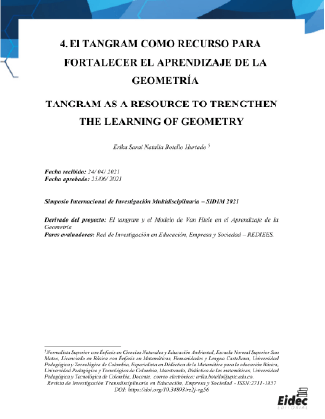IV. TANGRAM AS A RESOURCE TO TRENGTHEN THE LEARNING OF GEOMETRY
##plugins.themes.bootstrap3.article.main##
Abstract
The Colombian educational quality measured by national and international tests shows the enormous need to propose strategies to achieve urgent progress in school performance. When carrying out the analysis of the results obtained in the knowing 3rd tests for the José Antonio Galán Educational Institution of the municipality of Puerto Boyacá, difficulties are evidenced in the area of mathematics specifically in reasoning competence, and spatial thinking, it is for this reason This research focuses its efforts on strengthening geometric reasoning skills using Tangram as a resource following the Van Hiele model. Research under a mixed approach is developed in fourth grade students of elementary school during four phases, diagnosis, planning, execution and evaluation, which include the design, validation and application of instruments in a rigorous way such as: a perception survey, a entrance test, the development of 5 didactic sequences one for each Van Hiele phase that step by step and using Tangram generate a challenge and mental and gradual effort for students who finally manage to advance in their level of reasoning, this process is evaluated With the direct observation of the teacher, their qualitative reflections are recorded in field journals and a final test. The analyzed results showed significant advances in the students that will allow them to continue advancing in their reasoning processes.
Download Statistics
##plugins.themes.bootstrap3.article.details##
Tangram, Geometry, Van Hiele, Didactics, Learning
Molina M. (2012) Uso de materiales didácticos manipulativos para la enseñanza y aprendizaje de la geometría un estudio sobre algunos colegios de Chile. Sánchez, V. Llinares, S. (1996): Habitual school practices and problem solving situations: The case of Carlota», en Giménez, Llinares & Sánchez: Becoming Primary Teacher. Issues from Mathematics Education. Badajoz, Indugrafic, Shaughnessy, J.M. y B~w.F.,(1985), spadework prior to deduction in, geometry, The Mathematics Teacher, 1vol. 78, 419-428 Usiskin, Zalman, (1882) Van Hiele Levels and Achievement in Secondary School Geometry. Project.Chicago Univ., Ill.onal Inst. of Education (ED), Washington, DC.PUB DATE82GRANTNIE-G-79-0090NOTE231p. Vargas, G., y Gamboa, R. (2013). El modelo de Van Hiele y la enseñanza de la geometría. Uniciencia, 27(1), 74-94





